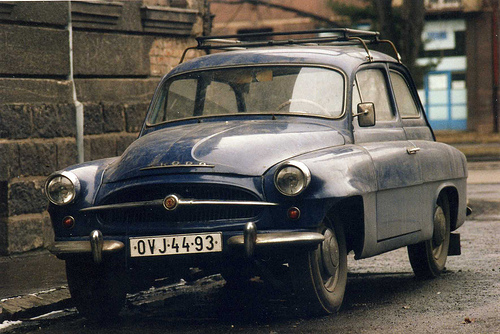The featured image is sourced from Flickr.
The Skoda Octavia is one of the most well-known global car brands. With the new model successfully winning prizes as the best family car, we take a look at the illustrious history of one of the most successful automotive models in the world.
Skoda’s first Octavia hit the roads in January of 1959. It was the eighth model off the production lines of Mladá Boleslav, around 50 kilometres north east of Prague, at the time owned by Czechoslovakian car group AZNP. Established as Laurin & Klement, the Bohemia-based firm would later become the Skoda we recognise today.
The Octavia’s popularity between 1959 and the rebranding in 1971 is difficult to gauge – it doesn’t feature heavily in automotive reviews of the time. Nonetheless, a late 70s BBC article pointed out Skoda’s “ubiquity on Britain’s roads”. The Octavia formed a key part of that, despite maintaining a relatively retro design philosophy. In comparison with AZNP’s other autos, though, the Skoda was forward-thinking; the bulk of Czech cars on the roads retained the rear-wheel drive system favoured by racing enthusiasts, despite the majority of the industry gradually converting to front-wheel-driven cars.
The 1959 Skoda Octavia brought all of AZNP’s prowess at building family cars from the ancestral Skoda 440. As well as sitting pretty at a relatively low 1,270kg (saloon version), the Octavia packed 40bhp via a 1.1-litre custom-built engine, rising to a 1.2-litre engine in the later station wagon models.
Despite the line’s initial demise in 1971, Skoda took a number of lessons from customer response to the Octavia. Many of the Octavia’s unique features were carried through to the beautifully-styled Skoda 1000MB, although a few were jettisoned – perhaps most notably, the engine moved to the rear of the newer vehicle line, supplying power directly to the rear wheels.
The Skoda Octavia as we know it was resurrected in 1996. The first iteration survived a spectacularly exhaustive run until 2010 – proof to many that Skoda’s design philosophy was actually as enduring as the family car concept itself. The Octavia has always been marked as being one of the most reliable vehicles money can buy. This, along with an extremely generous leasing scheme, helped the Octavia to establish its presence in the lucrative taxi market. For example, by 1998, the Octavia was the most common choice for a taxi vehicle in the UK.
As well as a redesign, the newer 1996 Octavia pushed up the power. The vehicle developed 123 bhp from a 1.8-litre 4-cylinder engine, codenamed ‘AGN’. The line’s most powerful factory-fitted engine arrived in 2001, with the advent of a 2.0-liter 4-cylinder standard variant and a souped-up ‘vRS’ variant developing 178 bhp through a 1.8. The latter demonstrated remarkably nippy road handling, perhaps enabled by the vehicle’s surprisingly large torque generation: 235 Nm between 1950–5000 rpm.
Sales of the 1996 model shot up to more than triple the initial year’s 47,876 by the advent of the new millennium. They progressively mounted from there – the recent figures from Skoda’s 2011 report pin Octavia sales at 387,200. It’s the brand’s best-selling line.
The second generation Octavia, for which production kicked off in March 2004, retained the original’s no-nonsense design philosophy while improving rear legroom and front ground clearance (two common complaints about the existing models). For the first six years, the model was known in India as the ‘Laura’, as Skoda continued to manufacture the original Octavia in that market (targeting a lower price bracket with the first generation vehicle). In 2010, those lines coalesced, and the ‘Octavia’ now refers to a single vehicle line across all continents.
Available in engine sizes ranging from the entry-level 1.3-litre up to the 2008-introduced 2.0-litre TSI “vRS” – in both petrol and diesel variants – the Octavia retained its image as a sensible, practical vehicle with a surprisingly nimble body beneath a serene veneer. Skoda previewed their Third-Generation Octavia a couple of weeks back (on the 11th of December 2012) at their ancestral home of Mladá Boleslav. Green technology, digital instrumentation and low-emission engines seem to be the focal points for development in the new version.

